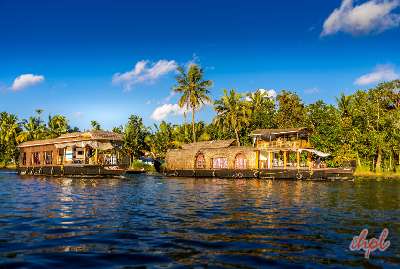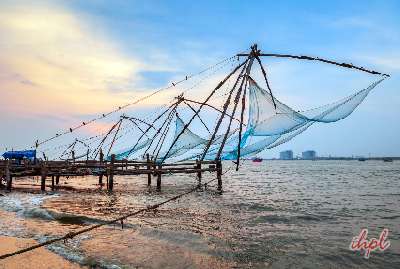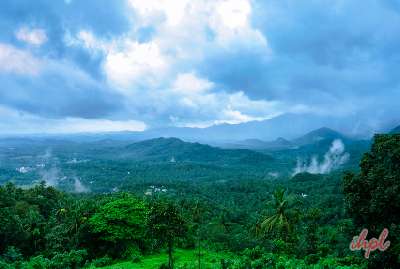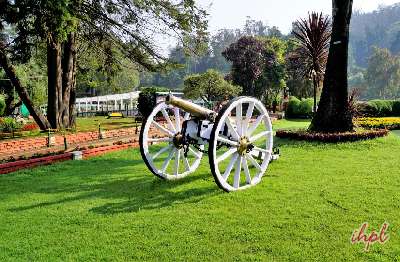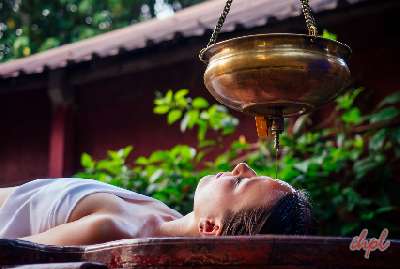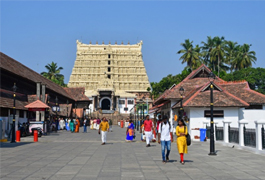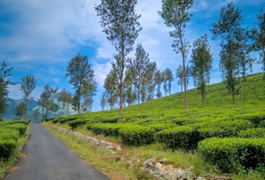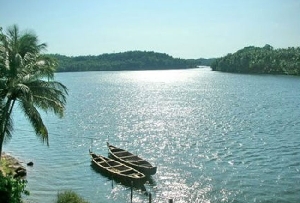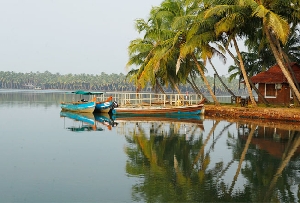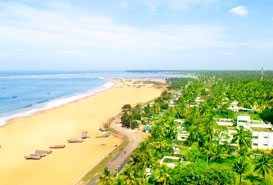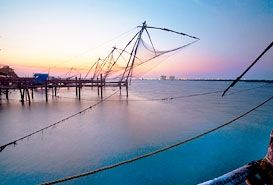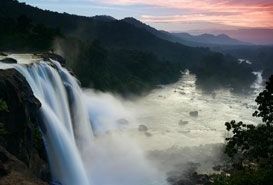The rich culture of Kerala manifests itself in several ways, led predominantly by the various ritual arts of Kerala, like the Kalamezhuthu.
A true artist sees the world as their canvas. The 40-day Kalamezhuthu festivities are held in Bhagavathy temples all over Kerala. The great gods of the area, such as Bhadrakaali, Ayyappan, Serpent, or Vettakkorumakan, are exalted and worshiped through the exquisite paintings that maestros create on the floor by combining coloured powders. These distinctive portraits, accompanied by the Kalamezhuthupattu, may be found everywhere, from temples to noble homes. The beats of several musical instruments, including the ilathalam, veekkanchenda, kuzhal, kombu, and chenda, serve as accompaniment as they are wiped at the conclusion of the process. Check out the amazing art in Kerala with our Kerala Tour packages.
What does Kalamezhuthu Art in Kerala signify?
One of the most exotic artistic expressions of Kerala, the ancient art of Kalamezhuthu, is one of Kerala’s most well-preserved ritual arts. The word Kalamezhuthu means the drawing of the “kalam” or image. Traditionally used as art to please various deities like Kaali, Ayyappan, or Vettakkorumakan, the ancient art of Kalamezhuthu is performed by skilled artists who draw powder drawings, or “dhulee chithram”, depicting the images of the deities.
How is Kalamezhuthu art in Kerala performed?
Using the floor as its canvas, the skilled artist performing the ritual art of Kalamezhuthu paints the portrait of the deity using only natural colors, which are made using materials like paddy (black), rice powder (white), dried and powdered leaves of Vaaka’-Acacia (green), turmeric powder (yellow) and a mixture of turmeric powder and quick lime (red). Using skilled fingers, the images made by these artists depict a range of emotions, which gives these images a characteristic picture. After the “kalam,” or painting, is finally completed, the boundaries of the image are made even more special by adding a sacred canopy of palm fronds, garlands of red hibiscus flowers, and thulasi, or Ocimum leaves.
Kerala Tour Packages
Things To Do in Kerala
- Kerala Tour Packages
- Kerala Tourism
- Best Time to Visit Kerala
- How to Reach Kerala
- Ayurveda in Kerala
- Famous Cities In Kerala
- Top Activities in Kerala
- Hill Stations in Kerala
- Backwaters in Kerala
- Kerala Cuisine
- Syrian Christian Cuisine Kerala
- Malabar Cuisine Kerala
- Seafood in Kerala
- Cultural Centers in Kerala
- Chavara Cultural Centre Kerala
- CVN Kalari Sangham Kerala
- Kerala Kalamandalam Cheruthuruthy Kerala
- Kathakali Centre Kerala
- Natana Kairali Research Centre Kerala
- Vijnana Kala Vedi
- Eco Tourism in Kerala
- Best Restaurants in Kerala
- Shopping in Kerala
- Kerala Art and Craft
- Fairs and Festivals in Kerala
- Aanayoottu Festival, Kerala
- Alleppey Tourism
- Best Houseboats and Cruises in Alleppey
- Restaurants in Alleppey
- Shopping in Alleppey
- Alleppey Temperature
- Anakkayam Tourism
- Aranmula Tourism
- Bekal Tourism
- Bhoothathankettu Tourism
- Chennamangalam Tourism
- Dharmadam Island Tourism
- Edakkal Tourism
- Ernakulam Tourism
- Aranmula Boat Race
- Aarattu in Kerala
- Adoor Gajamela Festival
- Adoor Mahalingeshwara Temple Festival
- Arattupuzha Pooram Festival
- Attukal Pongala Festival
- Champakulam Boat Race
- Chettikulangara Bharani Festival
- Chinakkathoor Pooram Festival
- Kochi (Cochin) Carnival, Kerala
- Easter Festival in Kerala
- Edathua Perunnal Festival
- Guruvayur Festival Kerala
- International Paragliding Festival
- Kadammanitta Padayani, Kerala
- Kanjiramattom Kodikuthu Kerala
- Kerala Village Fair
- Kodungalloor Bharani Festival, Kerala
- Kuttikkol Thampuratty Theyyam
- Machattu Mamangam Festival Thrissur
- Malanada Ketukazhcha Festival
- Malayattoor Perunnal Festival
- Neelemperoor Padayani Kerala
- Nehru Trophy Boat Race Kerala
- Nenmara Vallangi Vela Kerala
- Nisha Gandhi Dance Festival in Kerala
- Onam Festival Kerala
- Paripally Gajamela Festival Kerala
- Pariyanampetta Pooram Festivals, Kerala
- Parumala Perunnal Festivals Kerala
- Payippad Boat Race
- Pulikali in Kerala
- Sabarimala Festival in Kerala
- Swathi Festival in Kerala
- Thirunakara Festival in Kerala
- Thrissur Pooram Festival
- Uthralikavu Pooram Festivals, Kerala
- Vishu Festival
- Guruvayur Tourism
- Idukki Tourism
- Kadalundi Tourism
- Kannur Tourism
- Kasargod Tourism
- Arjuna Nritham
- Bamboo Mat Paintings Kerala
- Bell Metal Products
- Chavittunatakom Dance
- Coir and Coconut Shell Products
- Dances of Kerala
- Duffmuttu Dance
- Horn Carving Kerala
- Kakkarissi Natakom Dance
- Kalaripayattu Martial Art Form in Kerala
- Kannyarkali in Kerala
- Kathakali Dance in Kerala
- Kathakali Masks in Kerala
- Kavadiyattam Ritualistic Dance Kerala
- Crafts of Kerala
- Kolkali Dance Kerala
- Koothu Dance Kerala
- Krishnanattam Dance Kerala
- Kummattikkali in Kerala
- Kutiyattam Dance
- Margomkali Dance Kerala
- Kerala Martial Arts
- Mohiniyattam Dance Kerala
- Mudiyettu Ritual Art Kerala
- Oppana Muslim Dance Kerala
- Padayani Ritual Art Kerala
- Poothanumthirayum
- Ritual Arts of Kerala
- Rosewood Carvings of Kerala
- Theeyattu Ritual Art Kerala
- Theyyam Ritual Art Kerala
- Thiruvathirakali Dance Kerala
- Tholpavakoothu Ritual Art
- Thullal Dance Kerala
- Velakali Ritual Arts Kerala
- Wood Inlay Products Kerala
- Kochi Tourism
- Restaurants in Kochi
- Shopping in Kochi
- Kochi Weather
- Kodanad Tourism
- Kollam Tourism
- Kottayam Tourism
- Kovalam Tourism
- Restaurants in Kovalam
- Shopping in Kovalam
- Kozhikode Tourism
- Restaurants in Kozhikode
- Shopping in Kozhikode
- Kumarakom Tourism
- Restaurants in Kumarakom
- Shopping in Kumarakom
- Malampuzha Tourism
- Malappuram Tourism
- Munnar Tourism
- Restaurants in Munnar
- Shopping in Munnar
- Munnar Temperature
- Weekend Getaways from Munnar
- Palakkad Tourism
- Periyar Tourism
- Restaurants in Periyar
- Shopping in Periyar
- Sabrimala Tourism
- Thekkady Tourism
- Restaurants in Thekkady
- Shopping in Thekkady
- Thiruvananthapuram Tourism
- Restaurants in Thiruvananthapuram
- Shopping in Thiruvananthapuram
- Thrissur Tourism
- Shopping in Thrissur
- Tirur Tourism
- Places to Visit in Alleppey
- Alappuzha Beach
- Ambalappuzha Sree Krishna Temple
- Arthunkal Church in Alleppey
- Ayurveda in Alleppey
- Churches in Alappuzha
- Karumadi Temple in Alleppey
- Krishnapuram Palace in Alleppey
- Marari Beach Alleppey
- Nehru Trophy Boat Race
- Pathiramanal Island in Alleppey
- Revi Karuna Karan Memorial Museum
- St. Mary Forane Church
- The Vijaya Beach Park
- Thottappally Beach in Alleppey
- Tiruvalla Temple
- Tourist Attractions in Bekal
- Bekal Fort Kerala
- Tourist Attractions in Idukki
- Devikulam Hill Station
- Hill View Park in Idukki
- Idukki Arch Dam
- Kumily in Idukki
- Mangala Devi Temple in Idukki
- Pallivasal Falls in Idukki
- Pamba River Idukki
- Periyar Wildlife Sanctuary
- Tourist Attractions in Kannur
- Payyambalam Beach Kannur
- Thalassery in Kannur
- Valapattanam in Kannur
- Tourist Attractions in Kasaragod
- Ananthapura Lake Temple Kasargod, Kerala
- Chandragiri Fort Kasargod, Kerala
- Kottancheri Hills Kasargod, Kerala
- Ranipuram Hill Station Kasargod
- Valiyaparamba in Kasargod
- Places to Visit in Kerala
- Ayurveda in Ernakulam
- Ayurveda in Kollam
- Ayurveda in Kottayam
- Ayurveda in Kovalam
- Ayurveda in Kozhikode
- Ayurveda in Kumarakom
- Ayurveda in Palakkad
- Ayurveda in Thiruvananthapuram
- Ayurveda in Thrissur
- Ayurveda in Kerala
- Beaches in Kerala
- Cherai Beach in Kochi
- Marari Beach Alleppey
- Churches In Kerala
- Chaldean Church Kerala
- Christ Church Kerala
- Churches and Synagogues in Kochi (Cochin)
- Churches in Munnar
- Churches in Thrissur
- CSI Immanuel Church Kerala
- Paradesi Synagogue in Kochi
- Our Lady of Lourdes Cathedral Kerala
- Puttanpalli Church Thrissur, Kerala
- St.Andrew’s Forance Church
- St. Francis Church Kerala
- St. George’s Cathedral Kochi, Kerala
- Latin Catholic Church Alleppey, Kerala
- Backwaters in Alleppey
- Kasaragod Backwaters Kerala
- Kochi Backwaters
- Kollam Backwaters Kerala
- Kottayam Backwaters
- Kozhikode (Calicut) Backwaters
- Kumarakom Backwaters
- Kuttanad Backwaters, Kerala
- Thiruvallam Backwaters Kerala
- Valiyaparamba Backwaters Kerala
- Monuments of Kerala
- Museums in Kerala
- Ambalavayal Museum in Wayanad
- Archeological Museum Thrissur
- Hill Palace Museum Kochi
- Kerala Science and Technology Museum
- Krishnapuram Palace Museum Thiruvanantapuram, Kerala
- Napier Museum Trivandrum
- Natural History Museum Kerala
- Puthe Maliga Palace Museum Kerala
- Tata Tea Museum Munnar, Kerala
- Spice Plantations in Kerala
- Munnar Spice Plantations
- Thekkady Spice Plantation
- Wayanad Spice Plantation
- Temples in Kerala
- Padmanabhaswamy Temple Thiruvananthapuram
- Water Sports in Kerala
- Snake Boat Race Kerala
- Wildlife in Kerala
- Tourist Attractions in Cochin
- Andhakaranazhi Beach in Kochi
- Beaches in Kochi
- Cherai Beach in Kochi
- Chinese Fishing Nets in Kochi
- Ernakulam Shiva Temple Kerala
- Fort Kochi
- Jew town in Kochi
- Jewish Synagogue in Kochi
- Kodanad Elephant Training Centre Kerala
- Mahatma Gandhi Beach in Kochi
- Marine Drive
- Mattancherry Dutch Palace
- M.G. Road in Kochi
- Princess Street in Kochi
- Puthenthode Beach
- Santa Cruz Cathedral Basilica in Kochi
- St Francis Church
- Veeranpuzha Beach in Kochi
- Weekend Getaways from Kochi
- Tourist Attractions in Kollam
- Ashtamudi Backwaters Kerala
- Kollam Beach Kerala
- Mata Amritanandamayi Ashram Kollam
- Munroe Island Kollam
- Oachira Temple in Kollam
- Palaruvi Village Kollam
- Puthenkulam Elephant Village Kollam
- Shendurney Wildlife Sanctuary
- Thangassery in Kollam
- Tourist Attractions in Kovalam
- Halcyon Castle in Kovalam
- Hawa Beach in Kovalam
- Karamana River
- Lighthouse Beach
- Samudra Beach in Kovalam
- Vellayani Lake n Kovalam
- Vizhinjam Rock Cut Cave Temple
- Tourist Attractions in Kozhikode
- Weekend Getaways from Kozhikode
- Tourist Attractions in Kumarakom
- Aruvikkuzhi Waterfalls
- Bay Island Driftwood Museum
- Kumarakom Bird Sanctuary
- Kumarakom Houseboat Ride
- Vembanad Lake
- Tourist Attractions in Munnar
- Anamudi Peak
- Attukad Waterfalls
- Blossom International Park
- Cheeyappara Waterfalls
- Chinnar Wildlife Sanctuary
- Elephant Lake
- Eravikulam National Park
- Keezharkuthu Falls
- Kolukkumalai Tea Estate
- Kundala Lake
- Lakkam Waterfalls in Munnar
- Mattupetty Dam, Munnar
- Muniyara Dolmens in Munnar
- Pallivasal Falls
- Pothamedu View Point
- Salim Ali Bird Sanctuary in Munnar
- Tata Tea Museum in Munnar
- Thommankuthu Waterfalls in Munnar
- Thoovanam Falls
- Top Station in Munnar
- Trekking in Munnar
- Tourist Attractions in Periyar
- Periyar Lake
- Spice Gardens & Tea Plantations
- Tourist Attractions in Thekkady
- Bamboo Rafting in Thekkady
- Boating and Wildlife Sightseeing
- Bullock Cart Rides in Thekkady
- Elephant Ride In Thekkady
- Jeep Safari in Thekkady
- Mountain Biking in Thekkady
- Periyar Wildlife Sanctuary Kerala
- Spice Plantation in Thekkady
- Trekking in Thekkady
- Tribal Tour in Thekkady
- Tourist Attractions in Thiruvananthapuram
- Agasthyakoodam Peak in Thiruvanantapuram
- Akkulam in Thiruvananthapuram
- Kuthiramalika Palace Museum Thiruvananthapuram
- Neyyar Dam Thiruvananthapuram
- Padmanabhaswamy Temple Thiruvananthapuram
- Ponmudi Hills in Thiruvananthapuram
- Veli Tourist Village in Thiruvananthapuram
- Tourist Attractions in Thrissur
- Athirapally Waterfalls in Thrissur
- Basilica of Our Lady of Dolours in Thrissur
- Kodungallur Thrissur
- Paramekkavu Bagavathi Temple
- Vazhachal Falls in Thrissur
- Tourist Attractions in Varkala
- Tourist Attractions in Wayanad
- Banasura Sagar Dam
- Chembra Peak
- Edakkal Caves Wayanad, Kerala
- Neelimala View Point in Wayanad
- Pakshipathalam Bird Sanctuary Wayanad
- Pookode Lake in Wayanad
- Thirunelli Temple in Wayanad
- Thirunelly Village in Wayanad
- Wayanad Wildlife Sanctuary
- Varkala Tourism
- Restaurants in Varkala
- Shopping in Varkala
- Wayanad Tourism



